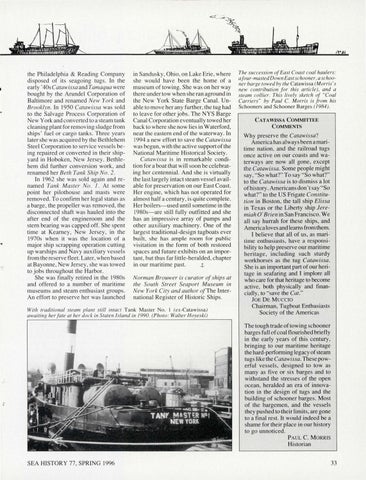the Philadelphia & Reading Company disposed of its seagoing tugs. In the early '40s Catawissa and Tamaqua were bought by the Arundel Corporation of Baltimore and renamed New York and Brooklyn. In 1950 Catawissa was sold to the Salvage Process Corporation of New York and converted to a steam tank cleaning plant for removing sludge from ships' fuel or cargo tanks. Three years later she was acquired by the Bethlehem Steel Corporation to service vessels being repaired or converted in their sh ipyard in Hoboken , New Jersey . Bethlehem did further conversion work , and renamed her Beth Tank Ship No . 2. In 1962 she was sold again and renamed Tank Master No. 1. At some point her pilothouse and masts were removed. To confirm her legal status as a barge, the propeller was removed, the disconnected shaft was hauled into the after end of the engineroom and the stern bearing was capped off. She spent time at Kearney , New Jersey , in the 1970s when it was the location of a major ship scrapping operation cutting up warships and Navy auxiliary vessels from the reserve fleet. Later, when based at Bayonne, New Jersey, she was towed to jobs throughout the Harbor. She was finally retired in the 1980s and offered to a number of maritime museums and steam enthusiast groups. An effort to preserve her was launched
in Sandusky, Ohio, on Lake Erie, where she wou ld have been the home of a museum of towing. She was on her way there undertow when she ran aground in the New York State Barge Canal. Unable to move her any further, the tug had to leave for other jobs. The NYS Barge Canal Corporation eventually towed her back to where she now lies in Waterford, near the eastern end of the waterway. In 1994 a new effort to save the Catawissa was begun , with the active support of the National Maritime Historical Society. Catawissa is in remarkable condition for a boat that wi II soon be celebrating her centennial. And she is virtually the last largely intact steam vessel available for preservation on our East Coast. Her engine, which has not operated for almost half a century, is quite complete. Her boilers-used until sometime in the 1980s-are stil l fully outfitted and she has an impressive array of pumps and other auxiliary machinery. One of the largest traditional-design tugboats ever built, she has ample room for public visitation in the form of both restored spaces and future exhibits on an important, but thus far little-heralded, chapter in our maritime past. ;t
Norman Brouwer is curator of ships at the South Street Seaport Museum in New York City and author of The International Register of Historic Ships.
With traditional steam plant still intact Tank Master No. I (ex-Catawissa) awaiting herfate at her dock in Staten ls/and in 1990. (Photo: Walter Hoyeski)
The succession of East Coast coal haulers: afour-mastedDown East schooner, a schooner barge towed by the Catawissa (Morris ' s new contribution for this article), and a steam collier. This lively sketch of "Coal Carriers " by Paul C. Morris is from his Schooners and Schooner Barges ( 1984 ). CAT AWISSA COMMITTEE COMMENTS
Why preserve the Catawissa? America has always been a maritime nation , and the railroad tugs once active on our coasts and waterways are now all gone, except the Catawissa. Some people might say, "So what?" To say "So what?" to the Catawissa is to dismiss a lot of history . Americans don ' t say "So what?" to the US Frigate Constitution in Boston, the tall ship Elissa in Texas or the Liberty ship Jeremiah O'Brien in San Francisco. We all say hurrah for these ships, and America loves and learns from them. I believe that all of us, as mari time enthusiasts, have a responsibility to help preserve our maritime heritage, including such sturdy workhorses as the tug Catawissa. She is an important part of our heritage in seafaring and I implore all who care for that heritage to become active, both physically and financially, to "save the Cat." JOE DE MUCCIO
Chairman, Tugboat Enthusiasts Society of the Americas The tough trade of towing schooner barges fu 11 of coal flourished briefly in the early years of this century, bringing to our maritime heritage the hard-performing legacy of steam tugs like the Catawissa. These powerful vessels, designed to tow as many as five or six barges and to withstand the stresses of the open ocean, heralded an era of innovation in the design of tugs and the building of schooner barges. Most of the bargemen, and the vessels they pushed to their limits, are gone to a final rest. It would indeed be a shame for their place in our history to go unnoticed. PAUL C. MORRIS Historian
SEA HISTORY 77, SPRING 1996
33
